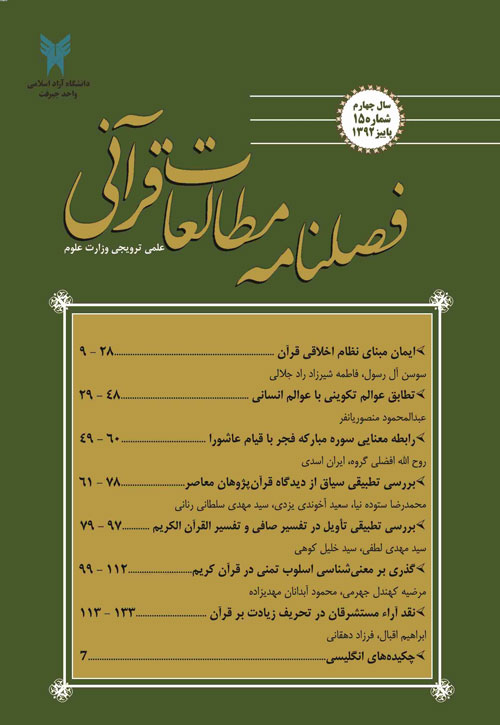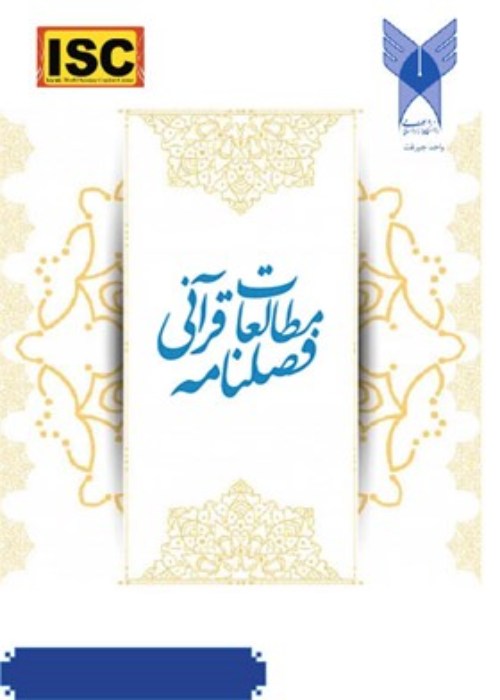فهرست مطالب

فصلنامه مطالعات قرآنی
پیاپی 15 (پاییز 1392)
- تاریخ انتشار: 1392/09/22
- تعداد عناوین: 7
-
-
صفحات 9-28نظام اخلاقی قرآن با سایر نظام های اخلاقی متفاوت است. نظامی است که مبنایش ایمان به خدا، غایتش ذات الهی، وسیله رسیدن به آن حب و کسب رضایت او، و شیوه تخلق به اخلاقیات در آن از بین بردن زمینه رذایل می باشد. وقتی انسان علم یقینی و ایمان به تعلیم قرآن کریم که عزت و قدرت را منحصر در خدای سبحان می داند داشته باشد، نه تنها دیگر در دلش جز خدا کسی را اراده نمی کند بلکه تمام پستی ها و بدی ها را از دل و جانش شسته و به زیور صفات الهی آراسته می کند. اخلاق قرآنی بر اساس حب الهی و تخلق به اخلاق الهی است. انسان از طریق خدادوستی به صفات خدا می رسد. معنای اینکه عملی به خاطر وجه الله انجام شود آن است که نتیجه آن عمل جلب خشنودی و رحمت خدا کند.کلیدواژگان: ایمان، نظام اخلاقی، عمل صالح، رذائل، فضائل
-
صفحات 29-48یکی از مباحث مهمی که از دیرباز و از دوران باستان در حکمت الهی و فلسفه و عرفان اسلامی مورد توجه متفکران، فلاسفه و عرفا بوده است، تطابق عوالم تکوینی با عوالم انسانی و یا به عبارتی انطباق عالم اکبر و عالم اصغر و به تعبیر دیگر عالم تکوین و عالم تشریع، و سرانجام تطبیق انسان کلی با هستی است. این مساله در فرازهای مختلف دعای سحر آمده و مفسران معاصر در شرح این دعا به این موضوع اشاراتی کرده اند. نگارنده سعی کرده تا این مساله را با نگاهی نو مورد بحث قرار دهد و نتایج حاصل از این مباحث را نقد و بررسی و تحلیل کند، و توجیه عقلی نظریه همبستگی علم ازلی الهی را با هستی و آفرینش بیان کرده و برداشت خود را از آن ارائه دهد.کلیدواژگان: مشیت، علم عنائی، قضا، قدر و سر قدر
-
صفحات 49-60سوره فجر در مکه نازل شده؛ 30 آیه، 139 کلمه و 509 حرف دارد، و همانند بسیاری دیگر از سوره هایی که در مکه نازل شده، آیاتش کوتاه، تکان دهنده، پر محتوا و همراه با هشدارهای فراوان است. از این جهت این سوره را «سوره حسین بن علی(ع)» نامیده اند که قیام و شهادت آن حضرت در آن تاریکی طغیان، مانند طلوع فجر، از نو منشا حیات و حرکت گردیده است. در این پژوهش معنی فجر و تعبیر آن، فضیلت سوره فجر، معرفی آن به عنوان حسین(ع)، و ارتباط با شب های دهگانه و چند قوم طغیان گر، و ارتباط آن با حسین(ع) بررسی شده است.کلیدواژگان: سوره فجر، امام حسین(ع)، نفوس مطمئنه، سوگند
-
صفحات 61-78بحث سیاق از مباحث کلیدی و زیربنایی در حوزه علوم قرآنی و اصول تفسیری است. این نقش کلیدی در حوزه های معارفی دیگر هم چون فقه و اصول نیز مطرح است. دانشمندان علوم قرآن و تفسیر، از سیاق بسیار یاد کرده اند و آن را مورد استناد قرار داده اند، ولی تعریف دقیقی از سیاق ارائه نکرده اند و هم چنین در تحقق سیاق، دو شرط ارتباط صدوری و ارتباط موضوعی را بیان کرده اند، که به نظر می رسد این دو شرط باید مورد واکاوی دقیق قرار گیرد و هم چنین حد و مرزهای قرائن قوی تر در مواجهه با سیاق به عنوان شرطی دیگر مورد بررسی قرار گیرد. در این مقاله نویسنده تعاریف مطرح شده توسط دانشمندان معاصر در علوم قرآنی و اصول فقه را بیان کرده و مورد نقد و بررسی قرار خواهد داد، و دقیق ترین تعریف را بر می گزیند.کلیدواژگان: سیاق، قرآن، تفسیر، اصول فقه، سیاق مشکوک
-
صفحات 79-97واژه تاویل در تفاسیر عرفانی و اثری نقش پررنگی دارد. در بین تفاسیر اثری، تفسیر فیض کاشانی به دلیل اشتمال آن بر تاویلات ائمه(ع) و به طور محدود تاویلات خود فیض از جایگاه ویژه ای برخوردار است. در بین تفاسیر عرفانی نیز تفسیر منسوب به ابن عربی مشتمل بر تاویلاتی است که منطبق بر معنا و مفهوم تاویل در حوزه عرفانی است. مقایسه این دو اثر از جنبه مفهومی و و روشی می تواند در روشن شدن مفهوم تاویل در این دو حوزه موثر باشد. در دو تفسیر مذکور گاه به دلیل وجود رویکردهای مشترک به مفهوم آیه، تاویلات مذکور در آن ها اشتراک یافته است اما در غالب موارد اختلاف اساسی در گونه تاویلات وجود دارد. این مقاله با بررسی رویکرد ابن عربی و فیض به تاویل به مقایسه تاویلات این دو در تفاسیر خویش می پردازد و به بیان نقاط اشتراک و افتراق آن ها می پردازد.کلیدواژگان: تاویل، تفسیر صافی، تفسیر القرآن الکریم، فیض کاشانی، ابن عربی
-
صفحات 100-112از جنبه هایی که در معنی شناسی قرآنی می توان از آن مدد جست اسلوب های ادبی می باشند، که به طور محسوسی در آیات الهی جلوه گری می نمایند. قرآن کریم پیام های والای خود را در قالب زیباترین اسلوب های ادبی بیان می دارد، تا از این رهگذر بتواند هدایتگر و روشنی بخش راه جامعه بشری گردد. از جمله این اسلوب ها، اسلوب تمنی است. هدف از مقاله حاضر این است که به بررسی این اسلوب در قرآن کریم بپردازد، و اغراض بلاغی که در حروف تمنی یعنی لیت، لعل، هل و لو به کار رفته است را ذکر نماید. سپس این اغراض را در آیه های قرآنی مورد بررسی قرار دهد.کلیدواژگان: قرآن کریم، اسلوب تمنی، معانی بلاغی، علم معانی، آرایه های معنایی قرآن
-
صفحات 114-133«تحریف» عاملی است که اصالت و اعتبار هر کتاب و هر کلامی را با آسیب همراه می کند. نسبت تحریف به قرآن مجید، خواسته یا ناخواسته در همین راستاست. نوعی از آن، تحریف به زیادت است که از سابقه چندانی برخوردار نیست و دانشمندان پیشین به سان دیگر انواع(نقصان و تغییر) به آن نپرداخته اند، اما در یکی دو سده کنونی، مستشرقان به این نوع تحریف دامن زده اند. موارد ادعائی حدود ده آیه است. آن ها با استناد به قرآن کریم و اسلوب و محتوای آن و مطالب برخی منابع روایی، تفسیری و تاریخی به طرح آراء خود مبادرت ورزیده اند. آراء آن ها با استفاده از همان منابع و روش خودشان، قابل بررسی و نقد جدی است. این مقاله در صدد طرح و نقد نیمی از نظریات در این راستا است(آیه 144 آل عمران و آیات مشابه؛ 1/اسراء؛ 38/شوری و 4/معارج) تا بدین وسیله مصون بودن قرآن کریم از این نوع تحریف نیز ثابت شود.کلیدواژگان: قرآن، رسول خدا(ص)، تحریف، مستشرقان، نقد، نظریه
-
Pages 9-28The Holy Qurans moral system is different from other moral systems. The Quranic system of morality is based on faith in Allah; its end is arriving at divine essence; its means are devotion to Allah and earnest endeavor to attain divine satisfaction; its behavior code is emulating moral codes and uprooting vice. When any human being arrives at certitude by relying on the divine teachings of the Holy Quran as the word of Allah Who is the sole source of honor and power, they would not admit anything ungodly and unholy into their hearts which are the sole abode of divine features. Quranic morality is based on divine love, divine ethics, love for Allah as a means to and reflection of divine features. Thus any act performed for and in Allahs name is one that aims at attracting His Divine contentment and mercy.Keywords: faith, Good deed, Moral system, The Holy Quran, Vice, virtues
-
Pages 29-48One of the important philosophical and mystical problems which is considered by Islamic philosophers and Gnostics is the correspondence between ontological worlds and human domains, in other words, the question whether there is a kind of correspondence between the universal man and the universe and between macrocosm and microcosm. This subject has been discussed in detail in Mohammad Qasim Khalkhalis book named "Exposition of Duae Sahar", which is the most complete interpretation of this Dua. The author of this article attempts to consider this doctrine from a new point of view.Keywords: Divine decree, Divine will, Mystery of predestination, Predestination, Providential knowledge
-
Pages 49-60Al-Fajr is a Quranic surah or chapter revealed in Mecca containing 30 verses, 139 words, and 509 letters. Like many other chapters that contain verses revealed in Mecca it is short, shocking, filled with substance, and delivers a lot of warnings. Therefore, this surah is called the Surah of Hussein Ibn Ali dealing with his martyrdom and uprising during and against an era of darkness rightly to act as a dawn and a new origin for life and movement. In this surah, we deal with many swears or oaths that are unique in their kind, such as when we swear by Fajr and we mean "the beginning of the rituals of the month of Muharram, to refer to Ashura and its relation to the start of the new year and the tenth day of Muharram in the year 61 AH, when the purest blood was shed, these are among many other issues which have been studied in this article.Keywords: Assured selves, Imam Hussein, The Holy Quran, Surah al Fajr, swear
-
Pages 61-78The subject of context is among the key concepts and subjects in the field of Quranic Sciences and the principles of exegesis. This key role of context is also evident in such sciences as Fiqh and Usul. Scholars in the field of Quranic sciences and exegesis have widely drawn upon this concept, but few of them have supplied an exact definition for the term, and while investigating the subject, they have offered a twofold category comprising of the two conditions, namely, relation by source and relation by subject. It seems that these two conditions need a careful study. Moreover, one should study the boundaries of stronger clues that decide context. This article attempts to study contemporary definitions of the term in order to arrive at the most exact definition.Keywords: Usul, context, Dubious, exegesis, Fiqh, The Holy Quran
-
Pages 79-97In mystical and traditional exegeses the word paraphrase is of essential importance. Among traditional exegeses, Feyz Kashanis Exegesis is important for its inclusion of paraphrases offered by the Holy Shia Imams and some of Feyzs own paraphrases are of special importance. Among mystical exegeses, too, Ibn Arabis exegesis includes paraphrases relying on mystical paraphrases. Comparing these two works focusing on concepts and methods can clarify the meaning of this act in both areas. In the mentioned exegeses, sometimes because of methodological similarity in studying the meaning of a Quranic verses or ayahs, the paraphrases are similar. However, in most other cases, there are essential differences between the paraphrases. This article attempts to study Ibn Arabis and Feyzs approach to paraphrasing both in theory and practice; thereby introducing the similarities and differences.Keywords: Feyz Kashani, Ibn Arabi, Paraphrase, Safi Exegesis, The Holy Quran Exegesis
-
Pages 100-112One of the Holy Qurans supremacies in eloquence and its flawless language is that it has a special manner of expressing different subjects, and since the Holy Quran has been revealed in a literary language, it expresses its extraordinary messages in the most beautiful and artistic style. One of these styles or methods is the optative style .The present article attempts to cite and study the verses displaying the use of the optative style.Keywords: Literary, Optative style, Semantic study, The Holy Quran
-
Pages 114-133Distortion is an issue that questions the originality and credibility of any book or mode of discourse. Attributing distortion to the Holy Quran has the same negative implications. One instance of the latest claims of distortion in the Holy Quran is that of addition, which is not so long standing, as older scholars had mainly discussed such claims as incompleteness and change. However, in the last two centuries, orientalists have spread this specific claim, referring to as much as ten verses. This claim is based on the orientalists understanding of the Holy Qurans texture, style, and content, in addition to their dependence on some sources on Islamic tradition, exegesis, and history. These claims are readily refutable relying on the same sources that have inspired such assertions. The present article attempts to critically analyze half of these so-called theories, in order to reassert the undisputable infallibility of the Holy Quran.Keywords: Critical Study, distortion, Holy Prophet, orientalists, The Holy Quran


